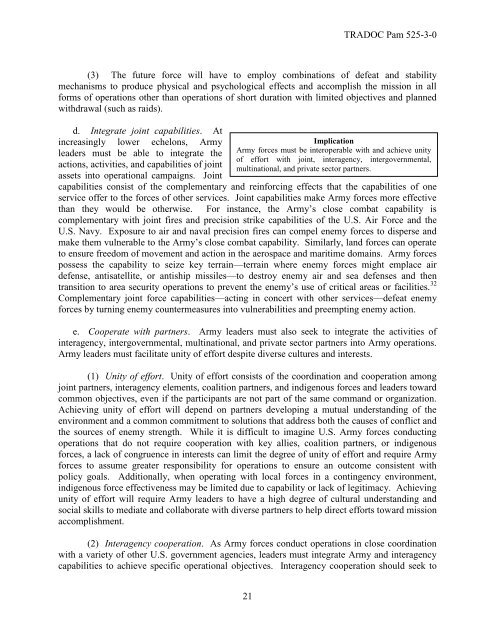(Pam) 525-3-0, The Army Capstone Concept - Federation of ...
(Pam) 525-3-0, The Army Capstone Concept - Federation of ...
(Pam) 525-3-0, The Army Capstone Concept - Federation of ...
Create successful ePaper yourself
Turn your PDF publications into a flip-book with our unique Google optimized e-Paper software.
21<br />
TRADOC <strong>Pam</strong> <strong>525</strong>-3-0<br />
(3) <strong>The</strong> future force will have to employ combinations <strong>of</strong> defeat and stability<br />
mechanisms to produce physical and psychological effects and accomplish the mission in all<br />
forms <strong>of</strong> operations other than operations <strong>of</strong> short duration with limited objectives and planned<br />
withdrawal (such as raids).<br />
d. Integrate joint capabilities. At<br />
increasingly lower echelons, <strong>Army</strong><br />
leaders must be able to integrate the<br />
actions, activities, and capabilities <strong>of</strong> joint<br />
assets into operational campaigns. Joint<br />
Implication<br />
<strong>Army</strong> forces must be interoperable with and achieve unity<br />
<strong>of</strong> effort with joint, interagency, intergovernmental,<br />
multinational, and private sector partners.<br />
capabilities consist <strong>of</strong> the complementary and reinforcing effects that the capabilities <strong>of</strong> one<br />
service <strong>of</strong>fer to the forces <strong>of</strong> other services. Joint capabilities make <strong>Army</strong> forces more effective<br />
than they would be otherwise. For instance, the <strong>Army</strong>’s close combat capability is<br />
complementary with joint fires and precision strike capabilities <strong>of</strong> the U.S. Air Force and the<br />
U.S. Navy. Exposure to air and naval precision fires can compel enemy forces to disperse and<br />
make them vulnerable to the <strong>Army</strong>’s close combat capability. Similarly, land forces can operate<br />
to ensure freedom <strong>of</strong> movement and action in the aerospace and maritime domains. <strong>Army</strong> forces<br />
possess the capability to seize key terrain—terrain where enemy forces might emplace air<br />
defense, antisatellite, or antiship missiles—to destroy enemy air and sea defenses and then<br />
transition to area security operations to prevent the enemy’s use <strong>of</strong> critical areas or facilities. 32<br />
Complementary joint force capabilities—acting in concert with other services—defeat enemy<br />
forces by turning enemy countermeasures into vulnerabilities and preempting enemy action.<br />
e. Cooperate with partners. <strong>Army</strong> leaders must also seek to integrate the activities <strong>of</strong><br />
interagency, intergovernmental, multinational, and private sector partners into <strong>Army</strong> operations.<br />
<strong>Army</strong> leaders must facilitate unity <strong>of</strong> effort despite diverse cultures and interests.<br />
(1) Unity <strong>of</strong> effort. Unity <strong>of</strong> effort consists <strong>of</strong> the coordination and cooperation among<br />
joint partners, interagency elements, coalition partners, and indigenous forces and leaders toward<br />
common objectives, even if the participants are not part <strong>of</strong> the same command or organization.<br />
Achieving unity <strong>of</strong> effort will depend on partners developing a mutual understanding <strong>of</strong> the<br />
environment and a common commitment to solutions that address both the causes <strong>of</strong> conflict and<br />
the sources <strong>of</strong> enemy strength. While it is difficult to imagine U.S. <strong>Army</strong> forces conducting<br />
operations that do not require cooperation with key allies, coalition partners, or indigenous<br />
forces, a lack <strong>of</strong> congruence in interests can limit the degree <strong>of</strong> unity <strong>of</strong> effort and require <strong>Army</strong><br />
forces to assume greater responsibility for operations to ensure an outcome consistent with<br />
policy goals. Additionally, when operating with local forces in a contingency environment,<br />
indigenous force effectiveness may be limited due to capability or lack <strong>of</strong> legitimacy. Achieving<br />
unity <strong>of</strong> effort will require <strong>Army</strong> leaders to have a high degree <strong>of</strong> cultural understanding and<br />
social skills to mediate and collaborate with diverse partners to help direct efforts toward mission<br />
accomplishment.<br />
(2) Interagency cooperation. As <strong>Army</strong> forces conduct operations in close coordination<br />
with a variety <strong>of</strong> other U.S. government agencies, leaders must integrate <strong>Army</strong> and interagency<br />
capabilities to achieve specific operational objectives. Interagency cooperation should seek to
















